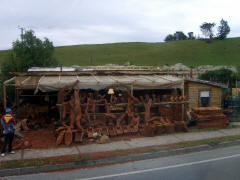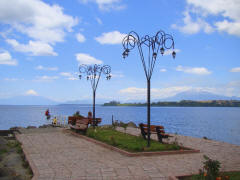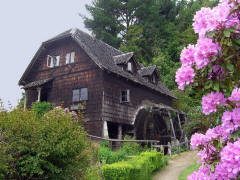Page 1 2 3 4 5 6 7 8 9 10 11 12 13 14 15 16 17 18 PUERTO MONTT Saturday, 19 December. During the night, the Veendam had left the channel and passed into the Gulf of Corcovado, then the Gulf of Ancud, both sheltered from the Pacific by Chiloe Island. While still an inner passage, these gulfs are vastly wider than the channels we had been following. When we woke up, though, the ship was already in Reloncavi Sound, on which Puerto Montt is located.
The ship arrived in Puerto Montt before 8:00. It was a beautiful
sunny day, though the clouds came and went throughout the day. The
temperature started in the mid-40s, but later reached the mid-50s.
With the Calbuco volcano right across the Sound,
Puerto Montt (pop. 130,000) lies in a setting that rivals Seattle
and Vancouver for its natural beauty. Its latitude is analogous to
Chicago's, so we were getting back to a more familiar climate. The
length of the days was also more familiar (sunrise 6:14 a.m.; sunset
9:25 p.m.). The city was founded by German settlers in 1852 and
their influence is still obvious.
After breakfast in our room, we took the tender ashore for our bus tour of Puerto Montt and the little town of Frutillar, in the Lake District. The bus left at 9:20 and drove us along the curving waterfront to the city center. Along the way, we passed a strange white, tepee-shaped metal observation tower called the Obelisk. Once downtown, we saw the main plaza and, facing it, the Cathedral (1856), built by the German settlers entirely of wood. The bus then climbed a steep hill behind the city center to give us a view of the city and Reloncavi Sound. That was it for the tour of the city.
We then headed north for Lake Llanquihue (pronounced YanKEE-way).
The one hour drive was very interesting. We had already seen in
Puerto Montt that many houses and other buildings had wooden shingle
roofs and siding. These are made of local alerce wood. It never rots
or deteriorates. On our ride we saw more such siding and also a
roadside stand selling various items carved out of alerce. The road
we traveled, incidentally, is part of the Pan American Highway. We reached the lake at the town of Puerto Varas at about 11:00. From the shore there was a great view of two volcanos (Orsorno & Calbuco). We were given 45 minutes to look around the shopping area. I took the opportunity to find an ATM and get some Chilean pesos (480 = $1.00). I then found Jane in the Artisans Market, a collection of independent vendors. We also went across the street to check out the local covered market that, in this season, was selling mostly Christmas items. Even the bottles of the local liqueurs (e.g., chocolate schnaps!) had Santa Clause heads on their necks. Back on the bus, we continued on to Frutillar, arriving about noon. The setting was breathtaking. Like Puerto Varas, Frutilar is on the shore of beautiful Lake Llanquihue, but much closer to the two snow-covered volcanos (Calbuco & Orsorno). The bus drove us around the town, then dropped us off near the German Colonial Museum, which most of us elected to visit. It was quite interesting, depicting how the early German settlers lived.
We still had enough free time to walk along the
lakefront and enjoy the view. The sky was now clear and sunny, except
for the clouds that hung over the volcanos, and even those were
constantly changing.
The bus left Frutilar shortly before 1:00 and we were back on the
pier in Puerto Montt in 45 minutes. The tender had us back on the
Veendam by 2:00. We had lunch in the Lido, then relaxed. The ship
sailed just before 6:00, nearly an hour later than scheduled.
After dinner in the dining room, we went to the 8:00 show, featuring Broadway music by the ship's singers. Just about as the show ended (9:00 p.m.), the ship cleared the Chacao Channel and entered the Pacific. That was the end of the inner passages. We would be in the open Pacific until the cruise ended in Valparaiso. I stayed up late to go to the "dessert extravaganza" at 10:30, not to eat anything but just to see it. AT SEA
Sunday, 20 December. I got up early and went to the gym at 7:00. The weather was partly cloudy and mild, and the sea was almost smooth. After breakfast in the Lido, we went to the debarkation briefing at 10:00 and the Valparaiso port talk at 11:00. In between, I went to the Front Desk to press the issue of compensation for our terrible experience with the flooded stateroom. After lunch I received a note advising me of a small shipboard credit, and later a phone call apologizing for the first time.
Just after lunch we passed Concepcion, Chile's
second largest urban area (after Santiago). A short time
later we sailed right over the spot that, ten weeks later, on 27
February 2010, was the epicenter of an 8.8 magnitude earthquake
that shook the country.
We spent most of the afternoon packing. There was a special farewell dinner at 5:15, concluding with a rather disappointing version of the traditional baked Alaska parade. Afterward, we finished packing and put our suitcases out in the hall. Page 1 2 3 4 5 6 7 8 9 10 11 12 13 14 15 16 17 18
Copyright © 2000-2023 DarrellPeck.com All rights
reserved. | |||||||||||||||||





















